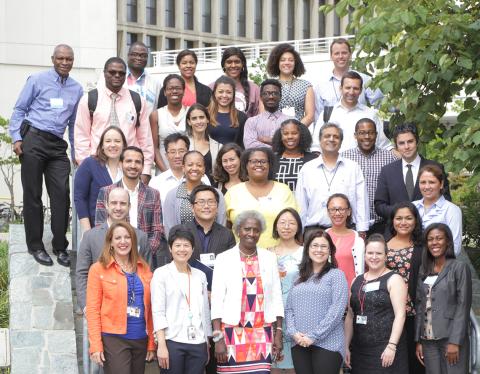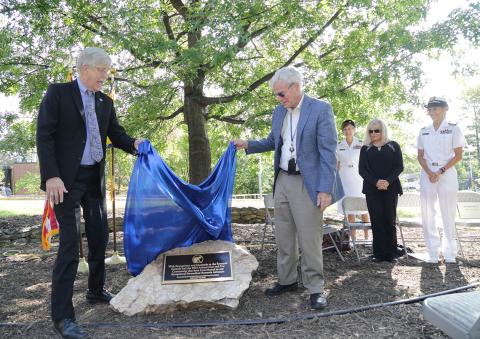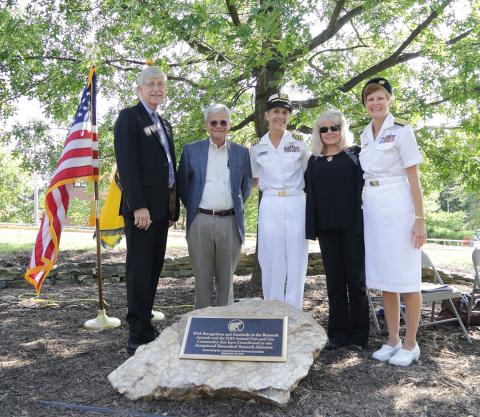Celebrating Our Scientists
NIH Honors Intramural Community at 30th Research Festival

Photo: Ernie Branson
“This field is just bursting wide open with opportunity and potential,” NIH director Dr. Francis Collins told an inquisitive audience member about epigenomics. His talk kicked off the 30th NIH Research Festival, held Sept. 14-16 in the Clinical Center.
Each year around this time, intramural researchers emerge from their labs to check out the work of their peers. While much attention is often lavished on extramural grantees throughout the country and world, Research Festival honors the nearly 6,000 investigators doing groundbreaking work in the CC and across campus every day.
Research Festival is designed in a way “that engages most of the community, doesn’t totally intrude on people’s research time, but gives people the opportunity to get out and get to know each other,” said NIH deputy director for intramural research Dr. Michael Gottesman.
This year, symposia highlighted the intramural community’s progress in precision medicine, inflammation and chronic disease, the microbiome and computational biology, to name a few topics. Postdocs and institute directors displayed and discussed their scientific posters. And investigators learned about new technologies and how to make their labs greener.
The Epigenome & Diabetes
Collins took off his director’s hat and spoke as an impassioned geneticist and intramural scientist, touting his lab’s recent advances in type 2 diabetes research. The disease afflicts some 30 million Americans and 80 million are at high risk, or pre-diabetic. Exacerbating the condition is chronic over-nutrition. “Insulin resistance inspired by obesity puts further stress on the pancreas…and ultimately beta cells fail to keep up and glucose rises,” he said.

Photo: Ernie Branson
Collins noted that researchers have had a tough time identifying contributing genetic variants because type 2 diabetes is not inherited in a predictable way. His NHGRI lab, in collaboration with the University of Michigan and Finnish investigators, has embarked on a genome-wide association study (GWAS). Globally, they’ve analyzed more than 30,000 DNA samples. Working with other groups, they have found at least 86 risk variants, called SNPs, for type 2 diabetes.
“The good news is we’ve been successful in utilizing this strategy to nail down a long list of risk factors for this complex polygenic condition,” Collins said.
But they almost had to guess which genes are involved because more than 90 percent of the variants discovered by GWAS are non-coding. Instead, they are regulatory variants.
Through genotyping and RNA-sequencing of relevant tissues, they’re starting to identify the target genes of these variants, which could provide a critical lead to new drug targets. Of these tissues, pancreatic islet cells seem to hold a big piece of the puzzle.
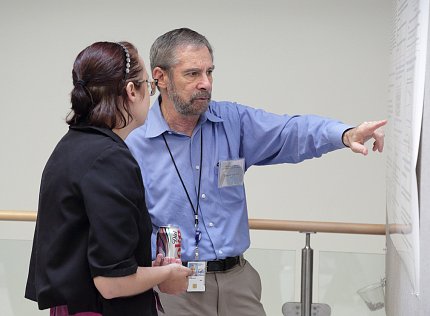
Photo: Ernie Branson
Searching through the non-coding parts of the genome can be daunting, but by utilizing epigenomic methods that allow identification of the parts that are functionally active, the Collins lab uncovered a theme. “Stretch enhancers,” so named because they contain DNA elements that enhance transcription of nearby genes and stretch over long distances, were discovered in areas of tissue-specific gene expression, said Collins. In type 2 diabetes, 61 of 86 GWAS signals fell within an islet stretch enhancer. Using methods that provide “footprints” of potential transcription factor binding, the lab zeroed in on the protein RFX6, which is only expressed in the pancreatic islet.
“We think we’re onto something here,” Collins said. “We’ve discovered a general phenomenon of pancreatic biology—variations in stretch enhancers in the islet—that play a role in type 2 diabetes. By having these technologies and these insights, we’re beginning to shed light on inherited risks and what we can do about that toward the development of interventions and new treatments.”
To Investigators: Use Your Imagination
Want to try out some innovative tools to expand your research potential? The NIH Library challenges NIH investigators to use some of its latest technology and think up novel ways to use these gadgets for basic and clinical research. Library staff is available to train and assist and then the sky’s the limit.

Photo: Ernie Branson
“We’re a world-class library that supports resources people need to do research in traditional ways, but we also go above and beyond to help create the ideal lab scenario,” said Kathleen McGlaughlin, communications librarian. “We want investigators to ask themselves: ‘How can I solve my research problem with this technology?’”
The NIH Library has 3-D printers that create colorful casts. Create a plastic gene or a brain or heart model. One NIH doctor used 3-D printing to create a protein model with a specific mutation for his patient, to help him understand his diagnosis, said Medha Bhagwat, bioinformatics support program coordinator.
Some investigators stopped by the NIH Library to test out virtual reality headsets. The stations featured games, a virtual underwater experience and a hospital room simulation. Several ICs are already testing out such realistic physical simulations for patient rehabilitation, such as allowing patients to practice certain tasks before they’re released from the hospital. VR technology has the potential to test medical students in a virtual clinic, provide surgical training and foster doctor-patient interactions remotely.

Photo: Ernie Branson
“We’ll make this technology available to you,” said McGlaughlin. “Use your imagination.”
The NIH Library also just launched a self-service digital production studio. NIH’ers can sample data visualizations and software, including smartpens, and try out the various recording gadgets to create presentations, or perhaps podcasts or tutorials, said Derek McDowell, NIH Library reference assistant. To learn more, visit nihlibrary.nih.gov/techhub.
Going Green
Laboratories generate a lot of disposables; many people don’t realize how much of that waste is recyclable or can be repurposed. At the Green Labs Expo, the Division of Environmental Protection’s Jacqueline McGauley and the Office of Research Facilities’ John Prom told investigators and staff about ways to reduce waste, safely dispose of solvents and how to properly recycle batteries, fluorescent light bulbs and thermometers. They also reminded NIH’ers to donate or seek out surplus solvents and equipment via NIH FreeStuff, http://stuff.nih.gov.
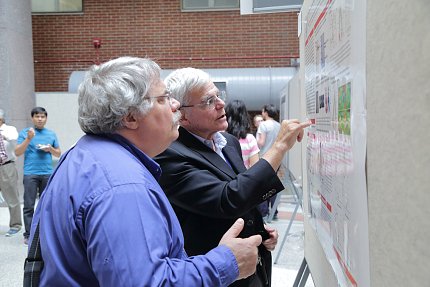
Photo: Ernie Branson
Research Festival enlightened and inspired and got researchers of all ages thinking about the future of their fields. Following his talk, Collins had some advice for that inquisitive audience member.
“Anybody who wants to work in this field, or virtually any other area in the way biology is going, needs to get very sophisticated about the computational part because that is clearly where the big insights are going to come from,” he said. “Big data sets are out there, made increasingly available because NIH is insisting on that kind of open data access. But the exciting and difficult part is making the most out of it, designing the right algorithms, building the right programs and knowing how to code and then coming up with those biological insights that otherwise might have been missed.”

